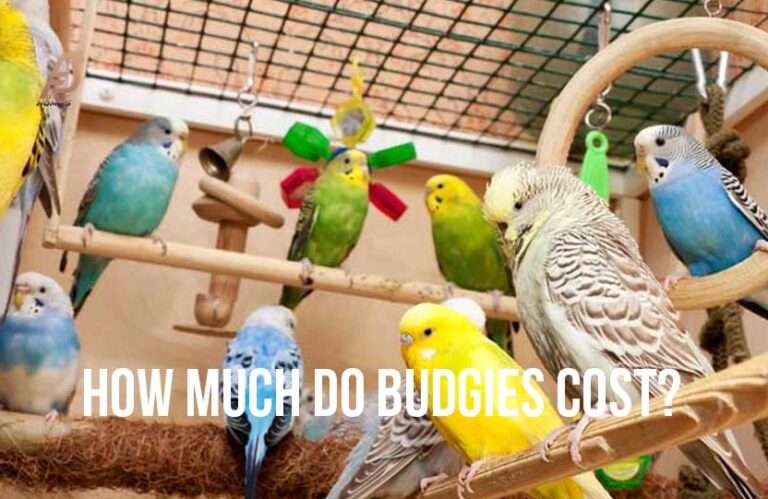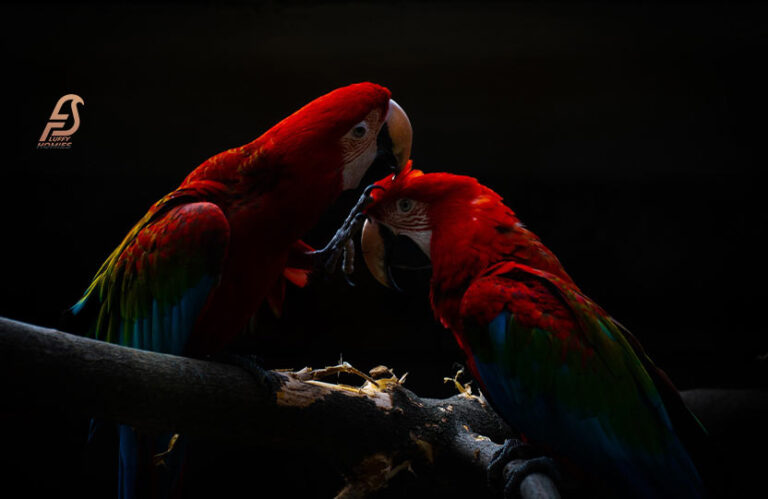Parrot Eyes Anatomy (Everything You Need to Know in 2024)
The intricate eyes of a parrot are an essential part of the bird’s anatomy. Parrot behavior and talents can be better understood by familiarizing oneself with the structure of their eyes.
Every component of these birds such as beak or eyes—from the nictitating membrane and eyelids to the shape of the eyeball itself—plays an important role in ensuring their survival and flourishing in their natural habitat.
The vibrant hues of parrot eyes, which can vary from species to species, are an interesting feature. We may learn a lot about a parrot’s health and vision just by looking at its eye coloring.
What makes studying parrot anatomy even more fascinating is the fact that some of these birds can see with just one eye, a phenomenon known as monocular vision.
Parrot Eyes Anatomy
The eyes of parrots and other birds are highly specialized to meet their demands. Because of their exceptional vision and arboreal habitat, parrots like emerald macaw have an unusual and fascinating eye structure. We can learn a lot about their visual perception by studying their eye shape.
It is essential for activities like searching for food including earthworms and recognizing possible mates that parrots have the unique capacity to perceive a broad spectrum of colors in their eyes.
Furthermore, parrots can focus on many objects at once thanks to their monocular eyesight. They can traverse their environment with great clarity and accuracy thanks to their specialized eyesight and excellent observational abilities.
Parrot Eyes Color
One of the most eye-catching features of these bright-skinned birds is their array of colorful eyes. Irises contain melanin compounds that define the eye color of a parrot.
Each bird’s eyes have their own distinct and attractive coloration, which can vary from dark browns and blacks to beautiful tints of blue, yellow, green, and even orange.
Not only do parrot eyes seem stunning, but they also perform important tasks in their everyday lives because of their array of hues.
One feature that makes each parrot distinct is its array of eye hues, which may be used to distinguish between several species.
Furthermore, their vibrant eye colors may have an emotional or sexually attractive function, enriching their social connections with others in their societies.
Monocular Vision
Parrots can focus on objects separately with each eye because of their monocular vision. Because of this peculiarity, they are better able to spot faraway predators and movements.
Because of their dual vision capacity, parrots can see more of their environment at once, which greatly improves their situational awareness.
For parrots to thrive in nature, the ability to precisely measure distances and sense depth through monocular vision is of utmost importance.
Because of this visual adaption, they can precisely navigate through thick foliage, find food sources, and escape danger. Parrots’ excellent spatial awareness is crucial to their day-to-day lives, and it all starts with their monocular eyesight.
Also Check: Are Budgies Smarter Than Dogs?

Parts and Functions of a Parrot Eyes
Eyelids and Nictitating Membrane
A parrot’s eyelids are very important because they shield the bird’s sensitive eyes from debris and other hazards. The parrot’s top and lower eyelids function similarly to those of a person in that they may cover and protect the eyes as needed.
Furthermore, the nictitating membrane is a distinctive third eyelid seen only in parrots.
Located in the inner corner of the eye, this semi-transparent membrane aids in maintaining the eye’s moisture and cleanliness. Additionally, it provides an additional barrier against environmental hazards like dust and debris.
Parrots have a built-in defensive system called the nictitating membrane that lets them swiftly clean the eye of any foreign objects or irritants.
The parrot’s eyesight is kept healthy and clear by its quick and effective movements. In addition, the nictitating membrane protects the body from harm, which is particularly important while doing things like flying or searching through thick foliage.
To protect the eyes of these interesting birds, the nictitating membrane and the eyelids of a parrot operate in perfect harmony.
Eyelashes
To keep dust, dirt, and other potential dangers out of their eyes, parrots rely on their eyelashes. These specially designed hairs line the perimeter of the eyelids to shield the delicate eye region from environmental aggressors.
In addition to protecting the parrot’s eyes from damage, eyelashes assist in maintaining their health by inducing a defensive blink reflex in reaction to contact.
Parrot eyelashes not only protect the eyes, but they also add to the bird’s beauty. Each species of parrot has its distinct beauty, and one of its distinguishing features is the length and thickness of its eyelashes.
Paying close attention to these minute details reveals not only how beautifully designed the natural world is, but also how even the most minute parts of a creature’s body may change and evolve.
Eyeball
A parrot’s visual system would be incomplete without its eyeball, which takes in light and processes it. The cornea protects the spherical eyeball, which contains the complex systems required for vision.
The multi-layered eyeball is an essential organ for parrots because it allows them to see their environment and find food.
The lens is an internal component of the eye that helps concentrate light onto the retina by positioning itself behind the iris and pupil.
Together with the cornea, this transparent and pliable structure filters incoming light, focusing it on the retina for analysis.
Parrots have an unusual visual system that allows them to see details and colors quite accurately. This is made possible by the intricate structures within their eyes.
Iris
An important function of the iris, a colorful circular structure situated between the parrot’s cornea and lens, is to control the quantity of light that reaches the eye.
Iris colors might range from brown to green to yellow to red or even blue, depending on the kind of parrot. Not only does this pigmentation make the bird seem prettier, but it also helps it adapt to changing lighting circumstances.
The regulation of pupil size—the black opening in the middle of the iris—is one of the iris’s primary tasks.
The iris narrows the pupil and the quantity of light that enters the eye when the light is bright because it contracts the muscles surrounding the pupil.
On the flip side, as the light level drops, the iris widens the pupil, allowing light to enter the eye and improving the bird’s eyesight in low light.
To maximize visibility and shield the delicate tissues within the eye from intense light, the iris may dynamically alter the size of the pupil.
Pupil
An essential component of a parrot’s eye, the pupil lets light in and guides it to the retina. Like a camera aperture, it may be enlarged or shrunk to control the quantity of light that enters the sensor.
Parrots have adapted their vision to work in a wide range of lighting settings, from very bright sunshine to very poorly lit areas. The effectiveness of their ocular system is demonstrated by their pupils’ ability to swiftly constrict or dilate.
In addition to regulating the quantity of light that reaches the eye, a parrot’s pupil may provide light on their emotional condition. When a parrot is excited or nervous, its pupils may widen to show how aroused it is.
On the other hand, when they’re happy or calm, their pupils may narrow to a smaller size. This automatic reaction adds another degree of fascination to the intricate visual system of these clever birds by giving onlookers a peek into their inner feelings.

Anterior chamber
The front chamber of a parrot’s eye is an important structure that keeps the eyeball in place and nourishes the tissues around it.
The correct functioning of the eye is ensured by the presence of aqueous humor, a watery fluid that fills this chamber and aids in regulating the intraocular pressure.
Parrots’ eyes have aqueous humor in the anterior chamber that helps filter out hazardous particles and nourishes the lens and cornea.
This fluid also helps flush out these structures of waste, which is good for the eye’s health and clarity generally. For parrots to have healthy eyes, their aqueous humor production and drainage must be balanced.
Posterior chamber
An important function of the parrot’s posterior chamber is to nourish the tissues around the eye and to keep the eye in its proper form.
Proper circulation and pressure management within the eye are made possible by this fluid-filled region, which is situated behind the iris and in front of the lens.
For a parrot to have perfect eyesight and excellent visual perception, the posterior chamber must be in good health and properly supporting the eye.
The ciliary body and zonular fibers collaborate in the posterior chamber to regulate the lens’s shape, allowing the parrot to concentrate on objects of different distances. The bird’s complex system allows it to adjust to its surroundings and improve its hunting and foraging skills.
The posterior chamber helps keep the parrot’s visual system healthy and functioning by filtering out harmful substances and providing nourishment to the eye’s components.
Lens
A parrot’s vision relies heavily on the lens of its eye. Situated behind the iris and pupil, it is a translucent and pliable structure.
Light entering the eye is primarily focused onto the retina by the lens’s ability to refract the light. Parrots can’t have keen vision without this exact focusing mechanism.
Light is distorted and refracted as it travels through the lens, creating an inverse picture on the retina. Through a process called accommodation, the parrot’s lens may change its shape, enabling it to concentrate on things at varying distances.
Parrots are excellent navigators and hunters in the wild because of their shape-shifting ability, which allows them to see clearly in all directions.
Retina
An essential part of a parrot’s eye structure is the retina. Rods and cones, two types of specialized cells called photoreceptors, make up this organ.
The parrot’s ability to see and sense its environment is dependent on these cells, which transform light into electrical signals that the brain can understand.
Parrots’ ability to see colors is due to cones in their retinas. Birds with a higher cone density than humans can see a broader spectrum of colors and finer details than humans can.
Parrots can see more clearly in the wild because their retinas include several kinds of cones, which allow them to differentiate between different shades of color.
Optic nerve
The optic nerve connects the retina to the central nervous system. This network of millions of nerve fibers carries visual data from the retina to the brain’s visual centers. Visual problems, including blindness, can develop from trauma to the optic nerve.
The optic nerve is responsible for more than just sending visual information; it also controls eye movements and pupillary reflexes.
Its importance in the visual system is underscored by the fact that its intricate structure enables the synchronization of different visual processes.
Fovea
Optical sharpness is sharpest at the fovea, a tiny dip in the retina. Color perception and acute central vision are mainly its functions.
The fovea, a region of the retina that is extremely important for color and detail vision, is home to a large number of cone cells.
The fovea’s unique structure allows humans to sharply focus on minute details. The fovea can focus light on things in our line of sight because it is situated in the exact middle of the macula.
For activities requiring fine detail, including reading or recognizing small objects, its central placement guarantees that the light entering the eye falls directly on the fovea, enhancing visual acuity.
The importance of the fovea in the human visual sense is highlighted by its function in delivering crisp and clear vision.
Parrot Eyes Anatomy Diagram

What is Special About Parrot Eyes?
Parrot eyes are among the most distinctive in the bird kingdom that makes birds smarter than cats. Because of their unusual eye structure, parrots can perceive not just a rainbow of hues, but also ultraviolet light.
Cone cells in their eyes are responsible for this capacity; these cells are sensitive to various wavelengths of light.
Pecten oculi are a thin membrane that parrots have that nourishes and increases blood flow to their retinas. As one of its unique adaptations, parrot eyes have a structure that is absent in other bird species.
Because of these unique traits, parrots have remarkable eyesight, which helps them see their surroundings and communicate with their colorful plumage.
Parrot Eye Infections and Problems
Eye infections may affect parrots just like they can any other animal. Bacteria, viruses, or irritating foreign objects are among the many potential causes of these diseases.
A parrot’s eyes could look red, swollen, discharged, and teary if it has an infection. If you think your parrot has an eye infection, you should take it to the doctor right away so it can get well and avoid consequences.
To keep your parrot from getting an eye infection and obesity, it’s important to keep its living space clean, take it to the doctor often, and keep it away from other ill birds.
A healthy, well-balanced meal that includes all the nutrients your parrot needs can also help keep it healthy and infection-free. You can help guarantee that your parrot lives a long, healthy life by taking an active role in maintaining their eye health.
How Many Eyes Does a Parrot Have?
Like the majority of birds, parrots have a pair of eyes on either side of their skull. Their ability to see both prey and predators in their natural environment is greatly enhanced by this bilateral configuration of the eyes.
Because of the way their eyes are positioned, they can view a wide area around them without turning their heads, which helps them fly and navigate.
Each eye of a parrot has an optic nerve, big cornea, lens, and retina that have evolved to meet their unique visual demands.
All of these parts come together to give parrots excellent vision for things like motion, color, and form.
One reason for their exceptional vision is the abundance of cones in their retinas, which enable them to differentiate between different colors and pick up on minute details in their surroundings.
How Many Cones Do Parrots Have in Their Eyes?
Parrot like lutino macaw eyes have an unusually high number of cones as compared to those of other animals. The parrot’s retina contains four different kinds of cones; this trait is known as tetrachromatic.
They have cones that enable them to perceive a broad spectrum of colors, including UV light—a wavelength that humans cannot perceive. Parrots rely on their superior color vision for a wide range of activities, including pinpoint navigation and food harvesting.
Parrots have an advantage over humans when it comes to color vision since their four cone types allow them to distinguish between hues that humans can’t see.
Parrots benefit greatly from this skill since it allows them to see well, which is essential for tasks like finding a partner, hiding from predators, and communicating with colorful plumage displays.
The extraordinary adaptations that parrots have acquired to fit their particular ecological niche are on full display in their sophisticated visual system.
Conclusion: Parrot Eyes Anatomy
The remarkable visual talents of parrots are a result of an intriguing combination of adaptations, as shown in the intricate architecture of their eyes.
To help them survive and engage with their environment, parrots have acquired unique traits, such as specialized structures like the posterior chamber and fovea, as well as many cones in their retina.
The significance of conservation efforts to preserve these remarkable animals and their unique visual systems is highlighted by the intricacy of their eyes, which provides insight into their sensory perception.
In addition, parrots’ receptivity to eye infections highlights how delicate their eye health is and how important it is to take preventative measures.
Understanding the causes and potential remedies for parrot eye infections will help us keep these fascinating birds safe.
The more we learn about parrot eyesight, the more we realize that these remarkable creatures’ eyes are a tribute to the wonders of evolution as well as a window into their environment.
Frequently Asked Questions
The pecten oculi and forward-facing posture of a bird’s eyes give them their characteristic structure. The retina of birds has cone photoreceptors that enable them to see in a certain way. Specifically, parrots’ eyes have evolved to include two separate fovea, which greatly improves their vision skills.
Unlike humans, parrots have a narrow binocular field, specialized eyes that face forward, and two separate foveas that allow them to see visual details more clearly. These changes allow parrots to engage in distinctive behaviors and ways of relating to their surroundings.
Parrots have a peculiar way of seeing things—their eyes are pointing forward, their binocular vision is small, and each eye has two foci that contain cone photoreceptors. Because of these changes, they can see better, which impacts their unique habits and relationships.






